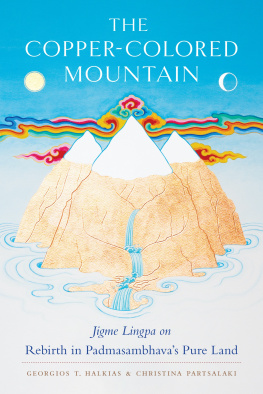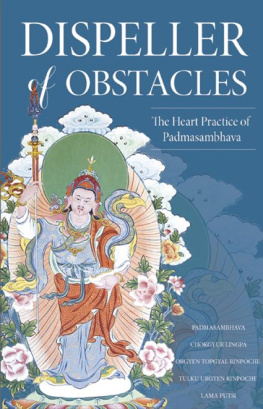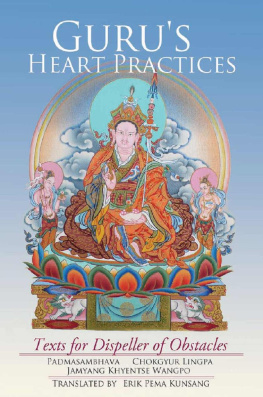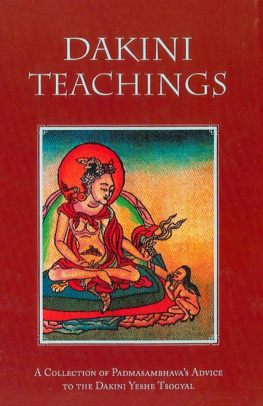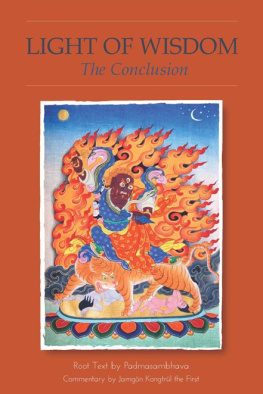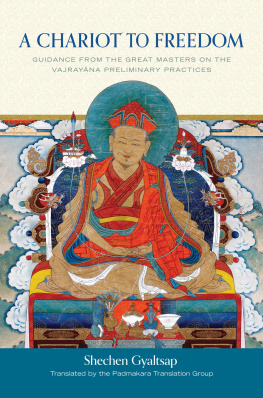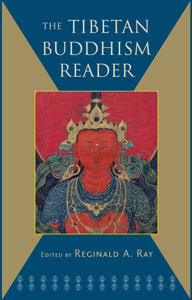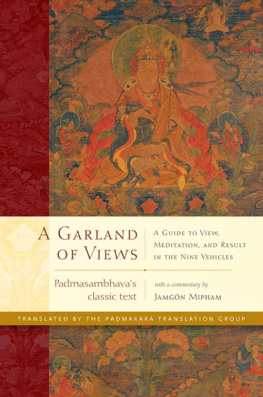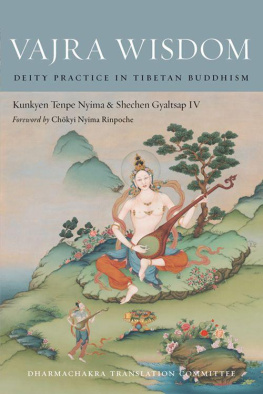A PRACTICE OF PADMASAMBHAVA
A Practice of Padmasambhava
ESSENTIAL INSTRUCTIONS ON THE PATH TO AWAKENING
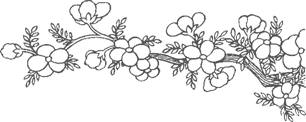
by Shechen Gyaltsap IV and Rinchen Dargye
Foreword by Chkyi Nyima Rinpoche
Translated by the Dharmachakra Translation Committee
SNOW LION PUBLICATIONS
ITHACA, NEW YORK
Snow Lion Publications
P.O. Box 6438
Ithaca, NY 14851 USA
(607) 273-8519
www.snowlionpub.com
Copyright 2011 Dharmachakra Translation Committee
All rights reserved. No part of this book may be reproduced without prior written permission from the publisher.
Printed in USA on acid-free recycled paper.
Painting of Vdisiha on p. 166 from the personal collection of Orgyen Tobgyal Rinpoche, photo copyright Rigpa International.
Drawings on pp. 16 and 1oo by Chris Banigan.
The print edition of this book was designed and typeset by Gopa & Ted2, Inc.
ISBN-10: 1-55939-362-9
ISBN-13: 978-1-55939-362-1
Library of Congress Cataloging-in-Publication Data
A practice of Padmasambhava: essential instructions on the path to awakening / by Shechen Gyaltsap IV and Rinchen Dargye ; foreword by Chkyi Nyima Rinpoche ; translated by the Dharmachakra Translation Committee.
p. cm.
Includes translations from Tibetan.
Includes bibliographical references.
ISBN-13: 978-1-55939-362-1 (alk. paper)
ISBN-10: 1-55939-362-9 (alk. paper)
1. Spiritual lifeTantric Buddhism. 2. Padma Sambhava, ca. 717-ca. 762. 3. Mchog-gyur-gli-pa, Gter-ston, 1829-1870. Bla mai thugs sgrub bar chad kun sel. I. Chkyi Nyima, Rinpoche, 1951- II. e-chen rgyal-tshab padma-gyurmed-rnam-rgyal, 1871-1926. Thugs sgrub bar chad kun sel gyi rim pa dapoi khrid kyi zin bris lha rdzas me tog. English. III. Karma-rin-chen-dar-rgyas, Mkhan-po. Bla ma smra bai segei phrin las blo gros dpal ster gyi rnam bad rab gsal snaba. English. IV. Dharmachakra Translation Committee.
BQ7690.P73 2011
294.3'444dc22 2010032835
Foreword by Chkyi Nyima Rinpoche
P ADMASAMBHAVA, the second buddha, is a kind and loving protector for all of us sentient beings. In particular, through his enlightened activity, the Buddhas teaching spread to the snowy land of Tibet where, like the sun shining in the sky, it became a source of happiness and awakening for countless practitioners.
While in Tibet, Padmasambhava concealed many of his teachings as spiritual treasures, meant to benefit future disciples. One of the masters who discovered these teachings was the great treasure revealer Chokgyur Dechen Shigpo Lingpa. An undisputed emissary of Padmasambhava, the treasures that he revealed contain a swift path to perfect and complete enlightenment. Fortunately, all of these teachings are still with us and available to anyone who seeks to awaken to enlightenment within this very life.
However, to engage in these practices, it is necessary to first meet a qualified master and receive the ripening empowerments, the supportive reading transmissions, and the liberating oral instructions. Having obtained such preparatory training, the student must then diligently put the teachings into practice. At that point, the instruction manuals composed by learned and accomplished masters to elucidate key points of meditation practice can become a true guide to ones progress on the path.
For this reason, I am pleased to present two important commentaries on the practice of Padmasambhava according to Chokgyur Lingpas profound treasure, Accomplishing the Gurus Mind: Dispeller of All Obstacles. These texts, which were prepared by the Dharmachakra Translation Committee, are composed by two of the great masters in the lineage. Divine Flower by Shechen Gyaltsap Pema Namgyal skillfully guides practitioners through the preliminaries and the main part of practice according to the general principles of Accomplishing the Gurus Mind. In contrast, Brilliant Light by Karmey Khenpo Rinchen Dargye, a direct disciple of the great treasure revealer himself, presents specific advice and guidance for the practice of Guru Vdisiha, the wisdom aspect of Padmasambhava according to this same cycle of teachings.
It is my wish that these texts will be of benefit for all practitioners of secret mantra who aspire to the accomplishments of the Lotus-Born Guru. May the merit that arises from this publication be a cause for the enlightenment of all beings, as far as space pervades.
Translators Introduction
I N THIS VOLUME, the reader will find translations of two commentaries on the practice of the enlightened teacher, Padmasambhava. This great master, also known as Guru Rinpoche, is accredited with establishing the Buddhist tantric teaching in Tibet during the golden age in the ninth century, a time when Buddhism benefited from a strong royal patronage. According to traditional accounts, during his Tibetan sojourn, Padmasambhava concealed numerous spiritual treasures, destined for revelation at later times. These concealed teachings would subsequently be discovered by a great number of extraordinary masters, or treasure revealers as they were called, who upheld Padmasambhavas legacy and propagated his teachings to practitioners in all the regions of Tibet. Both of the texts presented in this volume are rooted in, and draw their inspiration from, the revelations of the treasure revealer Chokgyur Lingpa (18291870), in particular his most influential revelation, the scriptural collection known as Accomplishing the Gurus Mind: Dispeller of All Obstacles ( Bla mai thugs sgrub bar chad kun sel ).
The first of the two commentaries, Divine Flower ( Thugs sgrub bar chad kun sel gyi rim pa dang poi khrid kyi zin bris lha rdzas me tog ), was composed by Shechen Gyaltsap Gyurme Pema Namgyal (18711926) and provides a detailed commentary on Accomplishing the Gurus Mind as a whole, treating both the preliminaries and the main part of practice. In contrast, the second text, Brilliant Light (Bla ma smra bai seng gei phrin las blo gros dpal ster gyi rnam bshad rab gsal snang ba), composed by Karma Rinchen Dargye (b. 1835), focuses on just one emanation of Padmasambhava, namely, Guru Vdisiha (or Lama Mawey Senge, as he is known in Tibet). Although this text is concerned with a particular aspect of Padmasambhava, most of its explanations and instructions are equally applicable to other practice manuals from Accomplishing the Gurus Mind and also the practice of the development stage as a whole.
As such, the two texts complement each other well and together provide a good introduction to the practices associated with this popular cycle of treasure teachings. As these precious texts are best studied in the company of an authentic master of the lineage, we highly encourage readers of this book to receive the proper explanations and transmissions related to these texts from a qualified lineage master. Therefore we shall here refer any philosophical and practical questions on the content of the commentaries to the relevant authorities and instead limit ourselves to a few observations on the historical context of the tradition to which the translations belong.
CHOKGYUR LINGPA AND THE NEW TREASURES
Chokgyur Lingpa, who revealed the treasure practices that concern this book, was born in the fall of 1829 at the retreat center of Gomde Dranang, situated in the eastern Tibetan region of Dokham. His father was the mantra adept Pema Wangchuk and his mother the practitioner Tsering Yangtso. We are told that, born amid auspicious signs of rainbow lights, he grew up to become an intelligent child who would naturally engage in meditation practice without formal training or prompting. At the age of eleven he experienced his first vision of Padmasambhava, which sparked the beginning of a long and fruitful career as a treasure revealer. The young Chokgyur Lingpa revealed his first treasure later that same year. Around this time he took novice vows, but it was not until later in life that he met his principal teachers. Thus, in 1853 at the age of twenty-four, Chokgyur Lingpa connected with Jamgn Kongtrul Lodr Thaye (18131899) and Jamyang Khyentse Wangpo (18201892), the great masters of his day with whom he was to develop a lifelong relationship.
Next page

